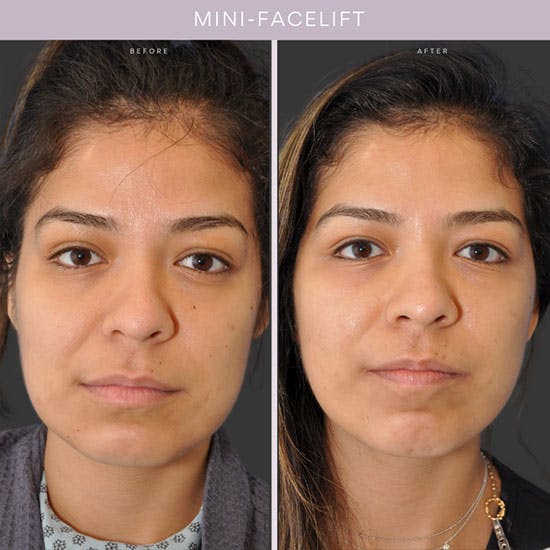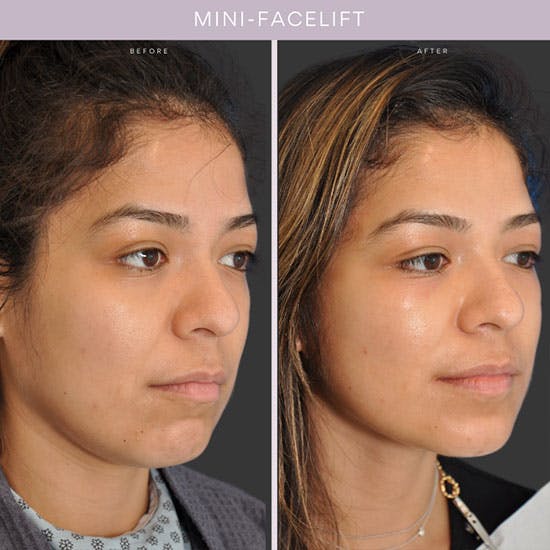WHAT IS A FACELIFT
A facelift, also known as a rhytidectomy, can dramatically reverse this downward trajectory, restoring volume and suppleness to the facial contour, tightening the jaw and necklines, and smoothing fine wrinkles and lines. This surgery addresses the fundamental changes related to natural facial aging. When performing his custom-tailored facelift surgery in New York City, Dr. Kwak repositions the underlying soft tissue and facial musculature layers, also known as the SMAS (superficial muscular aponeurotic system) to a more youthful anatomic position. By focusing the lift on these deeper layers, a more natural outcome is achieved.
However, any procedure targeting the face is by nature highly delicate and complex, as even the most subtle of alterations can have a significant impact on the total aesthetic. That is why it is so important to choose a facial plastic surgeon who specializes exclusively in this area.
Benefits of a Facelift
With the advent of facial fillers, neuromodulators, and nonsurgical treatments many ideal facelift candidates have been treated with these alternative options yielding patient dissatisfaction and overall costs similar to or often times greater than a facelift.
- Results that can last years, not months
- Precise control and direct changes to the facial anatomy - resulting in predictable real outcome.
- Superior outcomes than existing nonsurgical options
- Minimal scarring
- Easily combined with other procedures to enhance results
- Increased self-confidence
A facelift takes years off your appearance and provides a rejuvenated, refreshed look with minimal risk. Boost your self-confidence with a procedure that treats the underlying causes of aging by restoring a more youthful position for facial muscles, treating loose, drooping skin and tissue, redefining your jawline, and creating a beautiful, balanced facial appearance that looks natural, fresh and youthful.
What is Dr. Kwak’s Approach to a Facelift?
Dr. Kwak's facelift methods involve a harmonious blend of artistry and advanced surgical techniques. He understands that each patient is unique and requires a tailored, personal approach. Dr. Kwak always prioritizes natural-looking results, focusing on rejuvenation rather than radical transformation. His meticulous surgical skills minimize scarring, and he places incisions discreetly to ensure the most aesthetically pleasing outcomes. With a keen eye for detail and a commitment to patient satisfaction, Dr. Kwak combines his extensive experience with the latest innovations in facelift procedures, providing his patients with refreshed, youthful appearances that enhance their individual beauty.
Preparing for Facelift Surgery
Prior to the surgery, you will meet with one of our medical staff to review our preoperative/postoperative instructions and necessary prescriptions related to the surgery. We recommend obtaining a medical clearance from your primary care physician.
You will be expected to stop eating the night before your surgery date. Any medications that you have been advised to take by other medical practitioners will be reviewed by Dr Kwak or his staff.
If you live far away it may be best to plan to stay in a hotel located close to the clinic, our staff can assist you with finding accommodations.
In order to ensure the best care and safety for our patient, we require a nurse to stay with you for the first night after surgery, this service is included with your surgical fees. If you wish to extend this care from our skilled nursing staff, we are happy to assist.
What happens during the Procedure
On the day of your procedure you will meet with Dr. Kwak to review your plan and to ask any final questions prior to the surgery. Dr Kwak will perform surgical markings to customize the required surgery to your specific issues. If your surgery requires deeper sedation (general anesthesia), you will meet with our board certified anesthesiologist before the surgery.
Patients are then escorted by our nurse to our certified (AAAASF) operating room.
During the surgery, Dr Kwak will make an incision around your ears and into your hairline. The type of incision used minimizes all visible incisions, by placing part of the incision in the ear canal. Once this incision is made, Dr Kwak skillfully dissects the required anatomic areas customized to your type of facelift being performed. Once the required structures are isolated, Dr. Kwak will tighten the underlying facial musculature usually along a bidirectional vector, securing it in place with sutures. The overlying skin is then redraped and excess skin is removed. Thin medical-grade, skin-friendly sutures will be used to close the skin incisions. Small temporary surgical drains are often necessary for facelift surgeries. At the end, a light bandage is placed around the face.
Duration of the surgical Procedure
- A traditional deep plane facelift takes approximately 4-5 hours to be completed.
- The mini-facelift procedure takes approximately 2-3 hours to be completed.
- These are estimates and your specific surgical time can vary.
Complementary procedures to a facelift
A facelift may correct for mild neck laxity, however for those with significant neck laxity or other central anatomic variations such as excessive submental fat, prominent digastric muscles, or ptotic submandibular glands, a neck lift / deep neck lift (include link to other page) may also be recommended.
Facial Fat Grafting
Aging affects not only skin and muscle laxity but also the soft tissue volume changes. Some common areas where soft tissue volume changes are around the eyes (tear trough), cheeks (flattened midface), temples (hollow temples), and lips. A facelift will restore the skin and muscle laxity associated with aging, however facial fat grafting is frequently incorporated in facelift surgery. Facial fat grafting is a procedure that aims to extract fat from a patient, process it, and re-inject it into certain areas of the face to create a more youthful and harmonized appearance.
Dr. Edward S. Kwak employs an innovative extraction technique that allows him to harvest, handle, and relocate fat cells with minimal trauma, increasing the chances of a successful outcome for his patients.
While the facelift can improve deep etched wrinkles, some of the more specific aging changes associated with the skin, such as aged spots, fine wrinkles especially around the eyes and mouth, sun damage skin are better treated with laser therapy.
Laser skin resurfacing (link) is frequently performed simultaneously with facelift surgery to address the specific skin related changes with aging.
ALTERNATIVES TO A FACELIFT IN NYC
Patients who are not good candidates for surgery or do not want to opt for a surgical facelift still have plenty of options available. At Edward S. Kwak MD - ESKMD Facial Plastic Surgery, Dr. Kwak performs a variety of non-surgical facelifts that are designed to rejuvenate the face with little to no downtime.
Depending on the goals you want to achieve and your specific case, Dr. Edward S.Kwak can use dermal fillers, neurotoxins (Botox®️), lasers, or ultherapy to address sagging skin, wrinkles, and other common signs of aging.



















